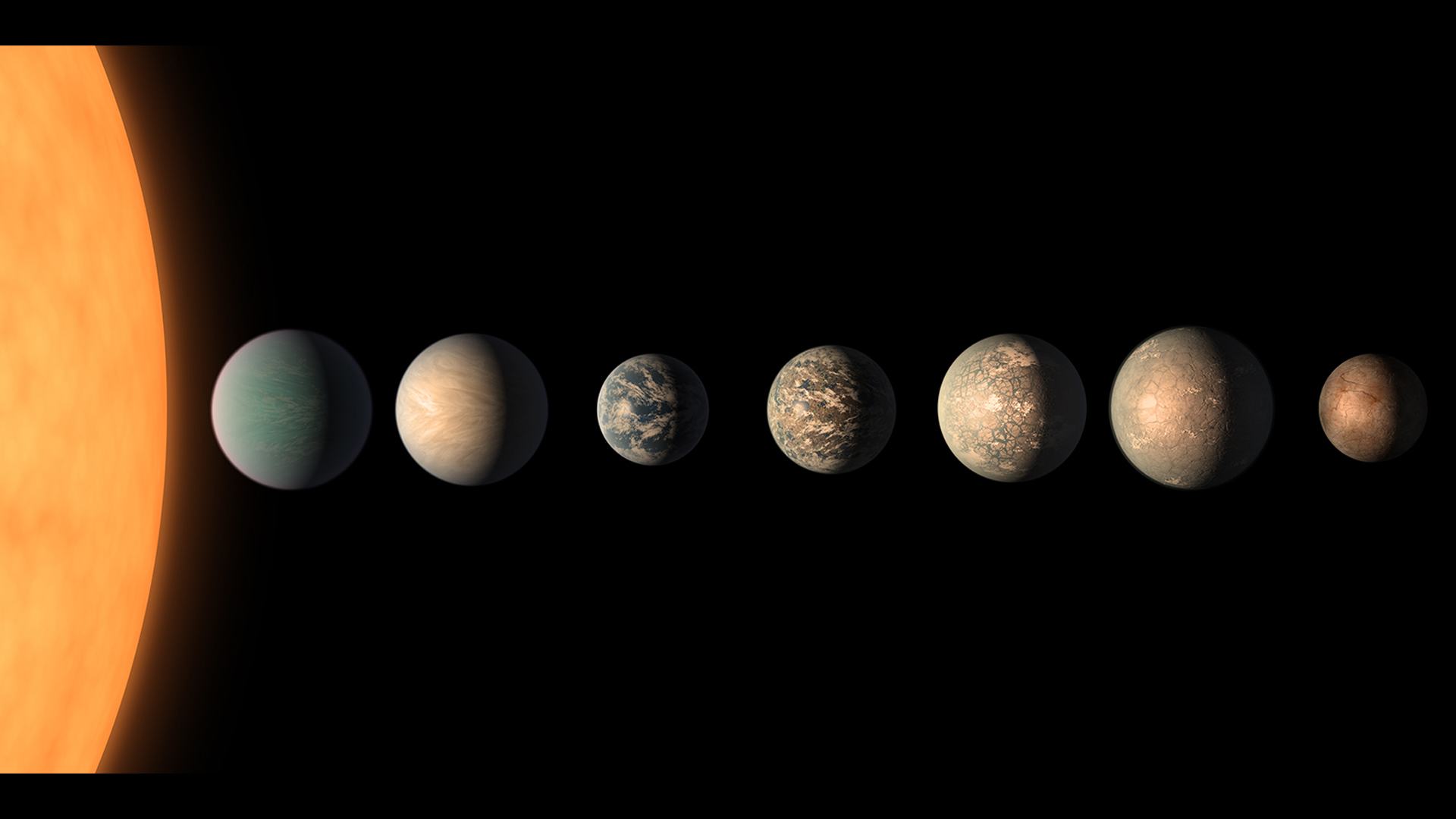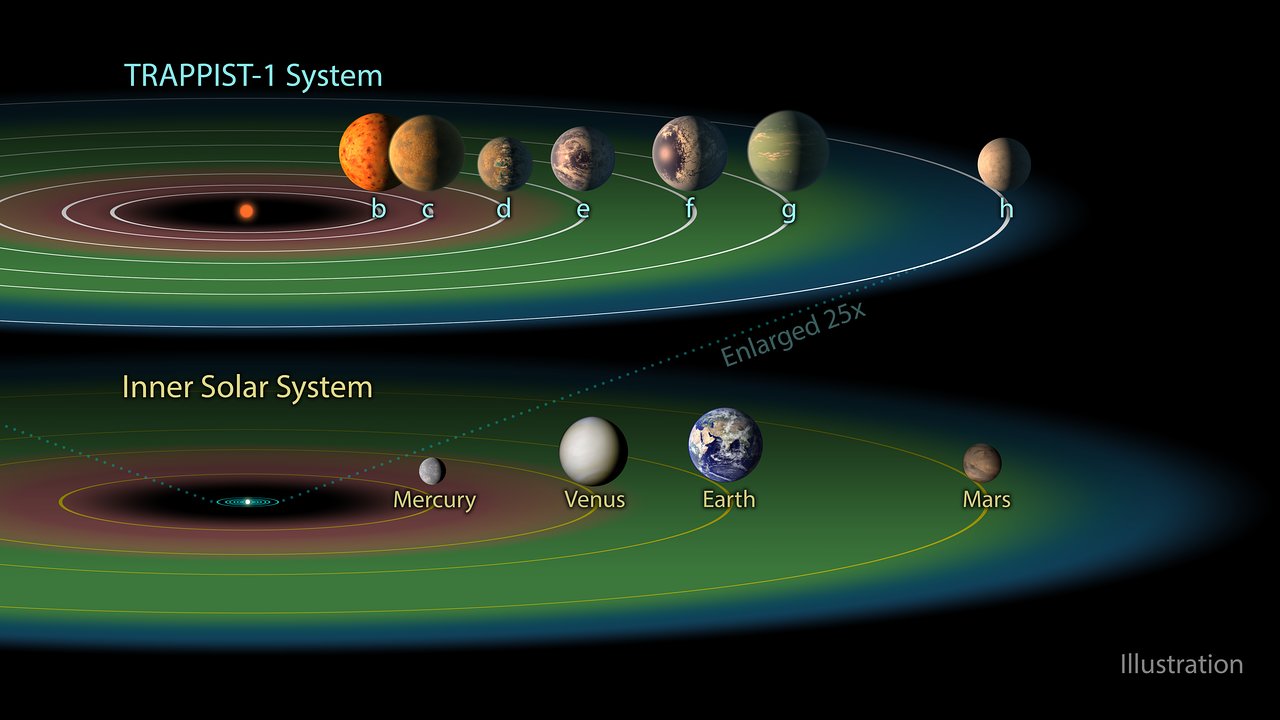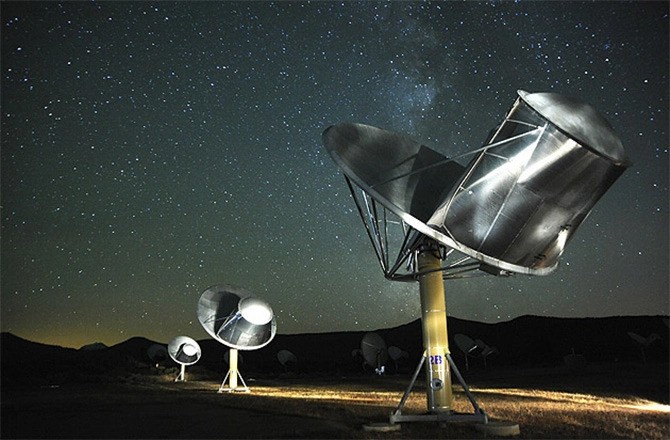
The latest hunt for alien signals in the TRAPPIST-1 planetary system has test-driven a new strategy that will allow astronomers to perform a more efficient, targeted search for technological extraterrestrial life in the future.
TRAPPIST-1 is a multi-planet system about 40.7 light-years away. Its seven rocky worlds, some of which lie in the habitable zone — the zone around a star where it isn't too hot nor too cold for a planet to host liquid water — are all bunched up so tightly that they transit their star every few days. The number of planets and their relative proximity to us make the TRAPPIST-1 system a tantalizing target for the search for extraterrestrial intelligence (SETI).
Although this latest search — in which the Allen Telescope Array of radio telescopes in California spent 28 hours in total listening to TRAPPIST-1 — did not detect any alien signals, "the point of the study was to demonstrate a more efficient search strategy, utilizing the natural orbital configuration of an edge-on multi-planet system to our advantage," Nicholas Tusay, a graduate student at Penn State University, told Space.com.
Traditionally, SETI has scanned the sky in search of powerful signals directed at us. However, after decades of not finding anything, SETI researchers are increasingly considering other strategies. These include searching for radio leakage: incidental transmissions not intended for us, but which might leak out from a planetary system. Such transmissions could range from communications and spacecraft emissions to radar or even the equivalent of alien TV. However, because this incidental leakage would not be transmitted with the intention of being heard light-years away, it would likely be of much lower power than deliberate signals would be.
The likelihood of us spotting such leakage by chance would thus be slim, so we need strategies that can improve the odds.
To this end, Tusay led the observations of TRAPPIST-1, which took advantage of a phenomenon called planet–planet occultations (PPOs). An occultation occurs when one object in the sky appears to move in front of another. As the seven TRAPPIST-1 planets orbit in a plane around their star that is almost perfectly edge-on to us, we can witness many PPOs, where effectively the two planets involved in the PPO and our detectors are all in a direct line.
Related: How AI is helping us search the universe for alien technosignatures
Now suppose that transmissions from the planet being occulted are directed at the planet doing the occulting. These transmissions might be communications similar to those from NASA's Deep Space Network (DSN), in which large radio transmitters in Canberra, Madrid and California keep in constant touch with our fleet of interplanetary spacecraft. Similarly, it is possible that during a PPO, when two planets and ourselves are in a line, we could pick up leakage from radio transmissions between the two planets from the alien equivalent of the Deep Space Network. That's what this latest survey of TRAPPIST-1 was hunting for.

"TRAPPIST-1 is the ideal laboratory because it has known transiting planets, nearly perfectly edge-on, and it’s so close that we have enough sensitivity to detect certain signals," said Tusay.
No signals were detected, but we needn’t be downhearted.
That's because the Allen Telescope Array is only sensitive enough to detect interplanetary transmissions at TRAPPIST-1 that are being broadcast with a power equivalent to an Arecibo-sized transmitter. Before it collapsed in 2020, the Arecibo radio telescope was a 305-meter (1,000-foot) dish. However, a powerful transmitter such as Arecibo would be “overkill” for interplanetary communications, said Tusay. The telescopes of the DSN are smaller in comparison with a lower effective power — too low for the Allen Telescope Array to detect. However, when it begins science operations towards the end of this decade, the Square Kilometer Array in South Africa and Australia should have the sensitivity to detect DSN-level transmissions during PPO events.
The Allen Telescope Array experiment has now shown that this PPO method is feasible. The ATA observed seven PPO events during the 28 hours it spent gazing at TRAPPIST-1 in 2022. In total it detected 25 million radio signals during that time.
"Most of that is radio frequency interference (RFI) from our own communications, so we needed to filter that out," said Tusay.

Radio frequency interference (RFI) is the terrestrial background of radio signals on Earth, from mobile phones to airport radar. In order to remove RFI from the observations more easily, Tusay developed something called the NBeamAnalysis pipeline. It is computer code that is able to distinguish signals that come only from the target, in this case TRAPPIST-1, from RFI that is seen in other directions in the telescope's field of view. By doing so, the code was able to whittle the 25 million signals down to just 2,264 that required further attention from a human being.
"Instead of looking through tens of millions of hits by eye, I only have to look through a few thousand, and most of them are still obvious to the human eye as RFI," said Tusay.
Ultimately, all the detected signals during the TRAPPIST-1 observations were RFI, but there are reasons why the Allen Telescope Array should keep looking. Although we can only guess as to the nature of an alien communication system and how often non-Earth beings would communicate with neighboring planets, comparing their signals to our own Deep Space Network is a starting point. Tusay's team estimates that the DSN is transmitting to Mars about a third of the time, meaning, on average, aliens would have to watch three PPO events of Earth and Mars to spot us sending a signal to one of our spacecraft around the Red Planet. If aliens are following a similar cadence at TRAPPIST-1, we'd have to watch at least three PPO events of each combination of planets to stand the best chance of spotting them.
This raises a question: Could aliens be watching for PPOs of planets in our own solar system? Those would happen more infrequently than in the TRAPPIST-1 system, where the planets are so close to their star that they orbit in a matter of a few days. Conversely, PPOs of Earth and Mars would take place approximately once every two years. In order to see a PPO of Earth and Mars, aliens would also have to be on a planet orbiting a star that is in the ecliptic on the sky, because the ecliptic is the plane of our solar system, and only by seeing this plane edge-on would they see any transits or occultations.
Nevertheless, "I know that searching for evidence that our own DSN transmissions have been picked up is an active area of investigation by other SETI scientists,” said Tusay. "I personally think that search strategy has merits."
In the meantime, we must keep listening to the sky — and thanks to these new observations of TRAPPIST-1, we at least now have a better idea of the best times during which to listen.
The findings are described in a paper that has been accepted for publication in The Astronomical Journal, and there is a pre-print available on arXiv.







